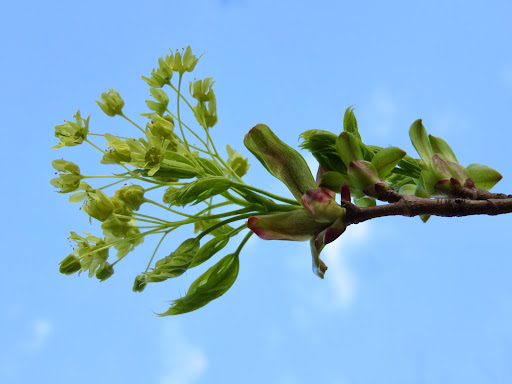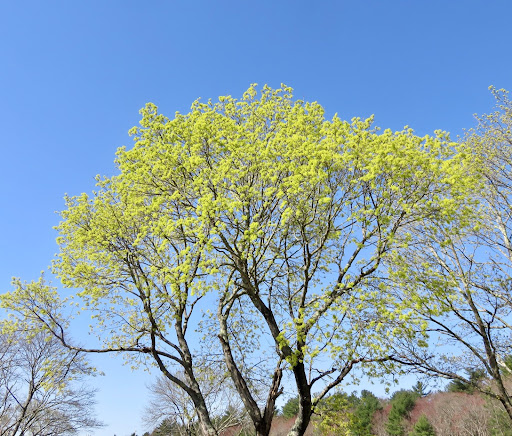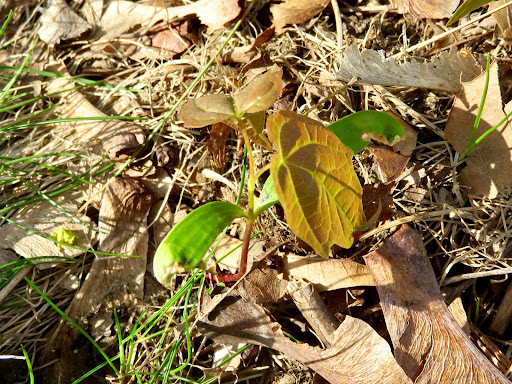Yesterday, as I did a quick inspection of the library’s grounds, the movements of a gray squirrel drew my attention. The animal was at a distance, in a tree on the opposite bank of our neighbor’s pond. I’m well accustomed to squirrel acrobatics, but something about its behavior struck me as different. As I watched, the reason became obvious: the squirrel was methodically picking and eating the flowers of Norway maple. This required running to the branch tips to snip the flower cluster and then carrying it back to a comfortable “table” on the limb. The squirrel munched each blossom, then dropped the twig and found another, much the same way that we chew on an ear of corn.
Watch the action in this brief video:
Despite wind and a shaky photographer, the clip clearly captures the squirrel’s method.
Suburban people, like those living in Southeastern Massachusetts, often see squirrels feeding like this:

In the wild, eastern gray squirrels rely extensively on “mast crops,” that is, the hard fruits of forest trees such as beech and hickory nuts and, formerly, American chestnuts. While acorns are the cornerstone food in our extensive oak forests, squirrels cannot rely on acorns alone. First, the abundance of acorns varies from year to year, which is a strategy employed by oak trees to ensure their own survival. The gray squirrel’s diet also shifts seasonally to take advantage of more succulent foods such as fruit, berries, fungi, buds and flowers. Hence, our squirrel’s attention to the Norway maple.
The North Carolina State Extension offers a factsheet on improving habitat for gray squirrels – yes, you read that right! –they are giving advice on how to attract and sustain more squirrels. While many backyard birders and homeowners perceive these animals as a nuisance, the presence of gray squirrels might be “justified” by the fact that good squirrel habitat – with mature hardwoods, a variety of tree species, and nesting cavities – is often good habitat for other species. The author of this factsheet, “Eastern Gray Squirrel: Working with Wildlife,” includes a list of “Species That Benefit from Gray Squirrel Management,” a chart of seasonal food preferences, and a nesting box plan.
Naturalist and educator Drew Monkman expresses a similar outlook when he says that gray squirrels are “important indicators of the health of local ecosystems.” In his essay, “Gray Squirrels in Action,” Monkman lists Norway maple keys as a fall and winter food for squirrels. “In the spring, their diet turns to tree buds, tree flowers and even Sugar Maple Sap.” The author of “Native Plants with Adams Garden,” a landscape designer, notes the same behaviors: feeding on Norway maple keys and flowers, and pruning branch tips “ to get a drink of the rising sap.” He approves of these activities by saying “anything that reduces seed production gets a gold star in my book.” This brings us back to the problematic tree.
You have probably heard that Norway maple is an invasive species. This does not mean that it is aggressive. Yes, it is a plant that can multiply rapidly and expand its range, but so can native species when conditions are favorable. The problem is that this non-native species causes ecological harm by displacing plants that have long been growing in North America and the animals that depend upon them. While the term “invasive” may imply ugly behavior, the plants themselves are often quite attractive. Here’s a closeup of Norway maple flowers like those our squirrel ate.

And, here’s a mature tree in flower.

The flowers are numerous and striking. Indeed, one way to identify this species in spring is to look for that yellow-green canopy. Once you recognize the shape and color, the scale of this maple’s “invasion” will be apparent. They’re everywhere! In parks, cemeteries, backyards, street plantings, and increasingly, in forests. Many of those flowers will result in samaras, those winged seeds that spiral in the wind like the blades of a miniature helicopter. Right now those seeds are germinating in lawns, leaf litter, sidewalk cracks, and more. Look at how many samaras surround this one maple seedling.

Because the young maple trees are shade tolerant, they can out compete many native trees. In time, this Norway maple will create dense shade that will prevent most groundcovers and understory plants from thriving. Moreover, this species has shallow roots that absorb most of the soil’s available water. And, if all of that wasn’t enough to discourage competitors, the Norway maple releases chemicals that are detrimental to other plant species, a phenomenon known as allelopathy. Where Norway maples thrive, species diversity is low.
It will take a stampede of hungry squirrels to keep this tree down. For the next few weeks, enjoy the splashy flowers and early foliage of the invader and be on the lookout for squirrels who forage among its branches. Soon this food source will pass, and the library’s gray squirrels will picnic elsewhere.
